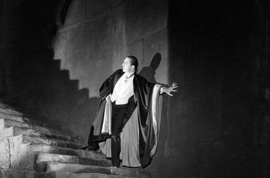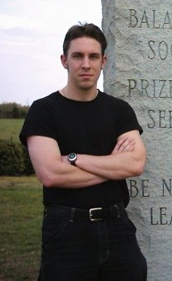Vampires 101
By Gail Bambrick
An Experimental College course takes a serious look at a phenomenon that just won’t die

A classic vampire: Bela Lugosi in the 1931 film Dracula. Photo: Getty Images
Do what you will—don a crucifix, ring your windows with garlic garlands, sharpen your wooden stakes. It won’t do you any good. Vampires are here to stay.
That’s the conclusion you might well draw from an Experimental College course this semester, “Vampires in Civilization.” Led by Joseph Laycock, author of Vampires Today: The Truth about Modern Vampirism (Praeger, 2009), the class takes a serious, scholarly and sometimes unexpected approach to understanding the undead.
“The first three weeks,” says Laycock, “are spent on Slavic studies, anthropology and psychoanalysis—the basis for a tool kit that students can use to approach vampires, or other topics in the humanities.” That means looking at sources ranging from Freud and Jung to anthropologists studying the folklore of medieval Eastern European villages. Fiction like Bram Stoker’s Dracula and the novels of Anne Rice soon come under consideration as well.
Laycock, who has a master’s of theological studies from Harvard Divinity School and is completing his doctoral dissertation on religion and society at Boston University, first started down the road to vampire studies while teaching high school in Atlanta. He was intrigued to find group there called the Atlanta Vampire Alliance that was conducting extensive research on people who identify themselves as vampires.
“What really interested me was not that they were vampires, but that they were doing a massive survey project of the global vampire population,” he says. “They recovered about a million data points from around 1,000 people.” And indeed, they had the same kind of research goals Laycock himself had as a grad student in his work on Harvard’s Pluralism Project, which studies America’s growing religious diversity. He had investigated how Asian religious groups become integrated into the mainstream; the self-professed vampires were trying to find out the habits and characteristics of other self-professed vampires. They were defining their identities through the survey data.
Laycock found that fascinating and ended up writing a paper about it, which he presented at a religious studies conference. The paper was later published in the journal Nova Religio, which got the attention of the Praeger publishing house and led to a book contract.
From Scapegoat to Romantic Hero

“Now we see the vampire very sympathetically. It’s no longer an outsider figure,” says Joseph Laycock.
One of the lessons Laycock has learned is that people’s preoccupation with vampires is both widespread and enduring. It would seem that on some level humans need vampires as much as vampires need blood. Representations of vampires cross many cultures and are evident from the Bronze Age to today, with TV shows like True Blood and books and movies like the Twilight series, he says.
In fact, Laycock sees Twilight as just the latest example of how vampires shape shift. Not only do they transform themselves into bats and other creatures, but they alter their dress, demeanor and ethics to reflect each new culture they encounter over the centuries. “Vampires change because we change,” he says.
Vampires’ original role in folklore was that of the scapegoat. “The vampire was outside society,” says Laycock. In Eastern European folk tales featuring vampires, villagers shared a common identity, wrapped up in their work and religion, and the vampire functioned as an exemplar of all that was forbidden, the source of troubles.
In the 21st century, by contrast, we can see the vampire as a romantic hero. “What’s interesting is that the current Twilight series is the most positive portrayal of vampires there has ever been,” says Laycock. “It was only beginning in the 1960s that we had this figure of the reluctant vampire, who feels very guilty. But with Edward Cullen, the lead vampire in the Twilight series, we don’t really even have that, because Edward has never killed anyone. He is a total innocent—he’s just different.”
One reason for the vampire’s new appeal is that the stark contrast between the outsider and the mainstream doesn’t hold as much power now. “Medieval villagers would never have had to worry about questions like, ‘Why does no one understand me?’ which are raised in Twilight,” Laycock says. “Now we see the vampire very sympathetically. It’s no longer an outsider figure. We relate to it, since we are all outsiders of a kind.”
Under such conditions, it may not seem so strange that some people, like those participating in the Atlanta Vampire Alliance research, would actually describe themselves as vampires. “This is for them an identity, not a religion,” Laycock says. “I applied the same ethnological methods I would have used with any group. Self-identified vampires are surprisingly normal people. The most common age is late teens and early 20s, but I met grandmothers and people of all ages.”
Yet even when we think of vampires as regular folks, they retain a special aura. They “tap into some of our large, universal issues: the mystery of death, the instinctual power of our libido and the life force symbolized by blood.”
And by the same token, vampires have long played a role in everyday life, even during times in history when they were universally hated and feared. Laycock explains that in medieval villages, widows would occasionally become pregnant—a potential scandal given that they were expected to remain celibate after the death of their husbands. But as long as everyone believed in vampires, these women had an out: they “could tell the town fathers, ‘Oh, that was my husband who came back from the dead. He’s a vampire.’ ”
Gail Bambrick can be reached at gail.bambrick@tufts.edu.
